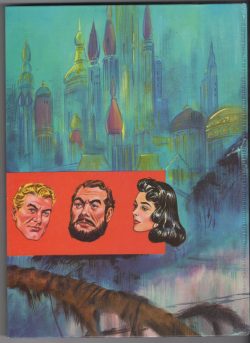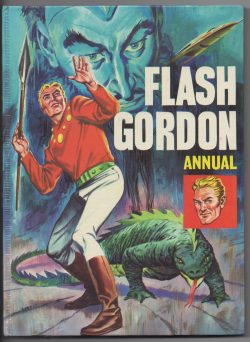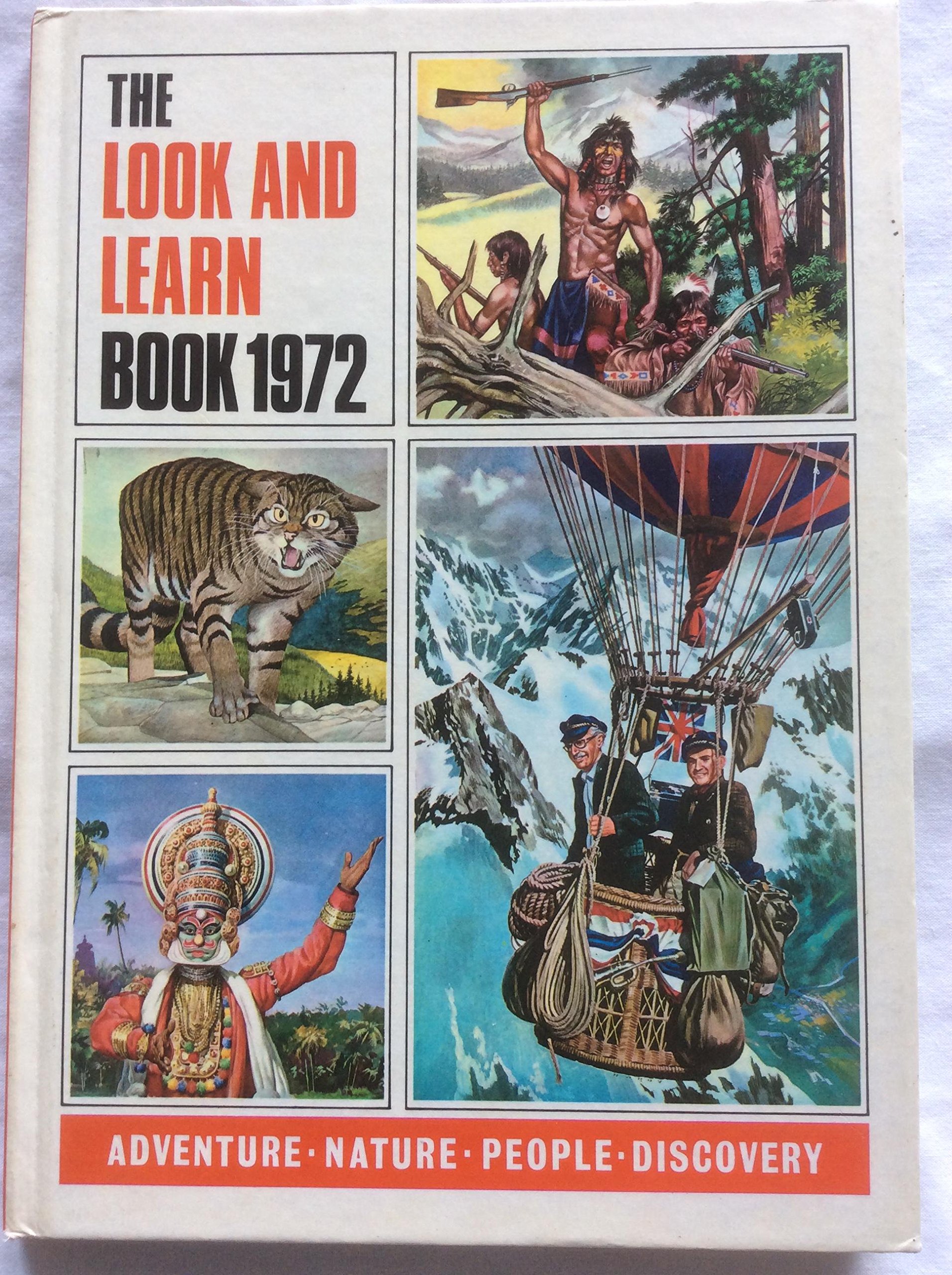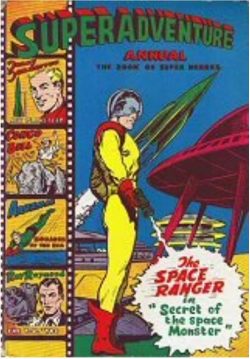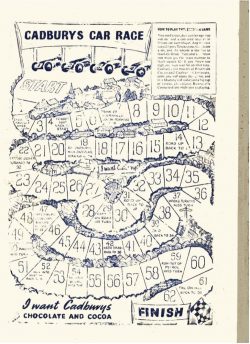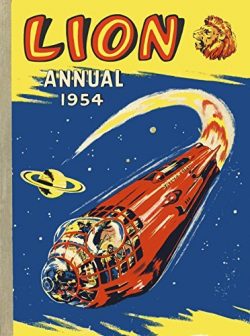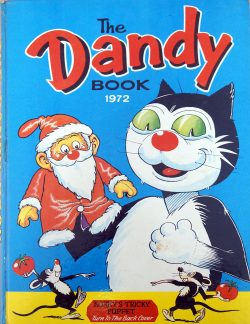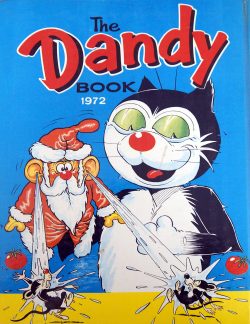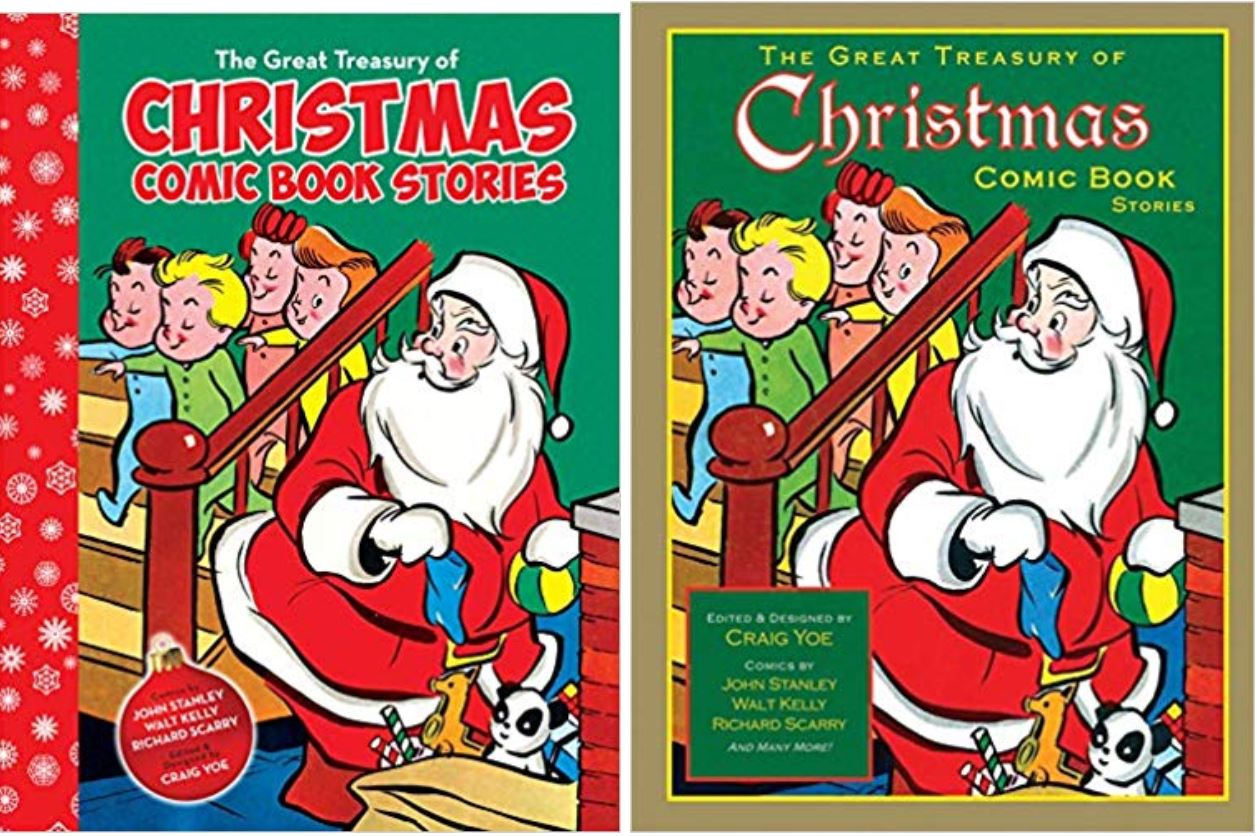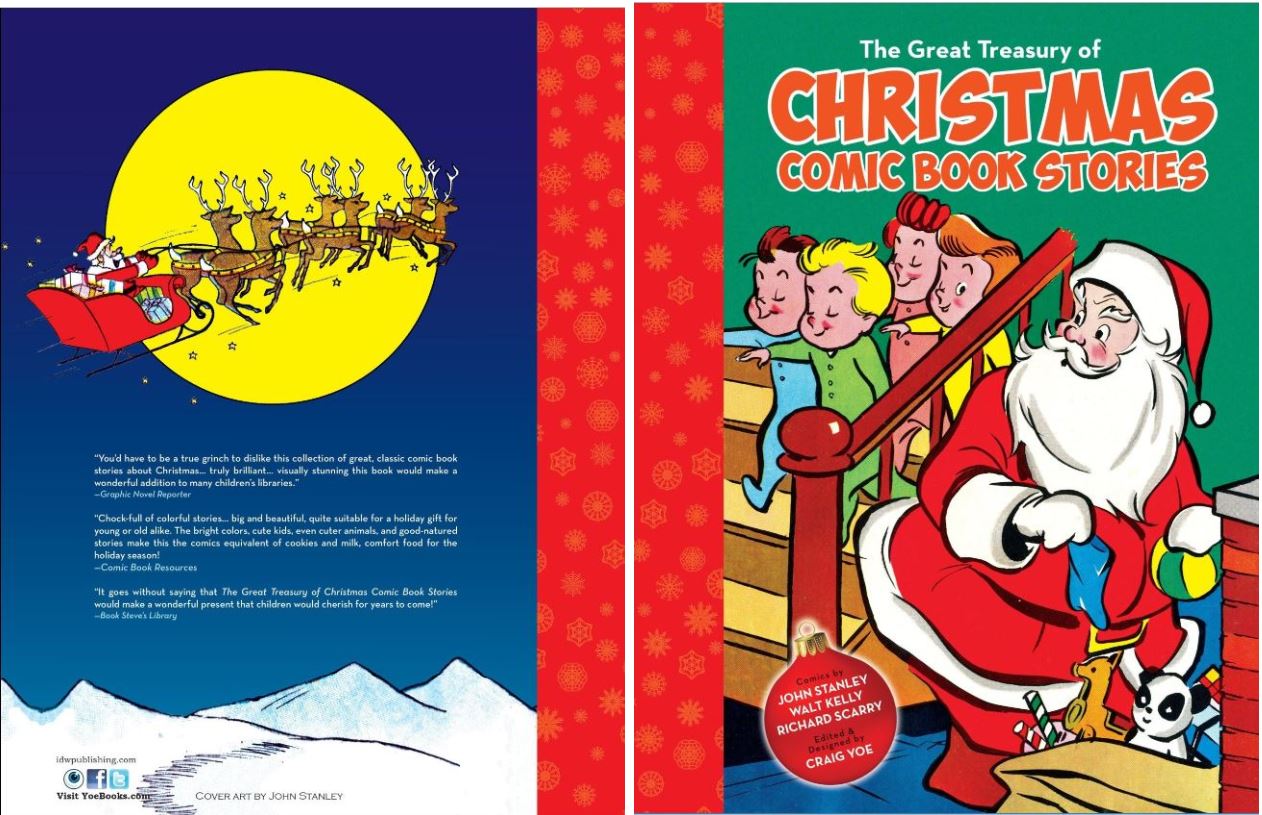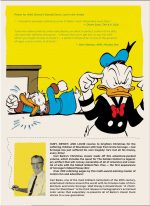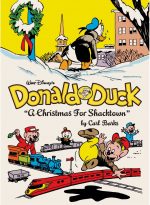
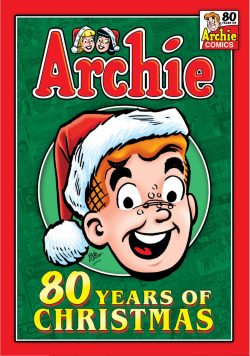
By Dan Parent, Angelo DeCesare, Francis Bonnet, Pat & Tim Kennedy, Bill & Ben Galvan, Jeff Shultz, J. Torres, Hal Lifson, Bob Bolling, Mike Pellowski, Dexter Taylor, Kathleen Webb, Dan DeCarlo & family, Stan Goldberg, Henry Scarpelli, Holly G!, John Lowe, Rudy Lapick, Frank Doyle, Dan DeCarlo, Alison Flood, George Gladir, Jon D’Agostino, Joe Edwards, Chic Stone, John Rosenberger, Dick Malmgren, Al Hartley, Joe Sinnott, Victor Gorelick, Bill Vigoda, Terry Szenics, Mario Acquaviva, Harry Lucey, Tom Moore, Harry Sahle, Bob Montana & various (Archie Comics)
ISBN: 978-1-64576-927-9 (TPB/Digital edition)
Win’s Christmas Gift Recommendation: An Unmissable Tradition… 9/10
As long-term readers might recall, my good lady wife and I have a family ritual we’re not ashamed to boast of or share with you. Every Christmas, we barricade the doors, draw the shutters, stockpile munchies (healthy ones, because we’re old now), bank up the fires and lazily subside into a huge pile of seasonal comics from yesteryear.
(Well, I do: she also insists on a few monumental feats of cleaning and shopping before manufacturing the world’s most glorious and stupefying meal to accompany my reading, gorging and – eventually, inevitably – snoring… Oh, so much snoring and from all ends!)
The irresistible trove of funnybook treasures generally comprises older DC’s, loads of Disney’s and British annuals, but the vast preponderance is Archie Comics.
From the earliest days this American institution has quite literally “owned Christmas” via a fabulously funny, nostalgically charming, sentimental barrage of cannily-crafted stories capturing the spirit of the season through a range of cartoon stars from Archie to Veronica, Betty to Sabrina and Jughead to Santa himself…
For most of us, when we say “comic books” thoughts turn to anthropomorphic animals or steroidal types, and women in too-skimpy tights and G-strings: hitting each other, bending lampposts and lobbing trees or cars about. That or stark, nihilistic crime, horror or science fiction sagas aimed at an extremely mature and sophisticated readership of confirmed fans…
Throughout the eight decades of the medium, other forms and genres have waxed and waned. One that has held its ground over the years – although almost completely migrated to TV these days – is the genre of teen-comedy, begun by and synonymous with a carrot topped, homely (at first, just plain ugly) kid named Archie Andrews.
MLJ were a small publisher who jumped on the “mystery-man” bandwagon following the debut of Superman. In November 1939 they launched Blue Ribbon Comics, promptly following-up with Top-Notch and Pep Comics. Content was a standard blend of costumed heroes and two-fisted adventure strips, although Pep did make a little history with its first lead feature The Shield, who was the American industry’s first superhero to be clad in the flag (see America’s 1st Patriotic Hero: The Shield).
After initially revelling in the limitless benefits of the Fights ‘N’ Tights game, Maurice Coyne, Louis Silberkleit and John Goldwater (MLJ, duh!) spotted a gap in their blossoming market. In December 1941 their stable of costumed cavorters and two-fisted adventurers were gently nudged aside – just a fraction at first – by a wholesome, improbable and far-from-imposing new hero: an unremarkable (except, perhaps, for those teeth) teenager who had ordinary adventures just like the readers might, but with the laughs, good times, romance and slapstick emphasised.
Inspired by the hugely popular Andy Hardy movies, Goldwater developed the concept of a youthful everyman protagonist: tasking writer Vic Bloom & artist Bob Montana with the job of making it all work. Their precocious new notion premiered in Pep #22: gap-toothed, freckle-faced, red-headed and obsessed with impressing the pretty blonde girl next door.
An untitled 6-page tale introduced hapless boob Archie and wholesome Betty Cooper. The boy’s unconventional best friend and confidante Jughead Jones also debuted in the story, as did idyllic small-town utopia Riverdale. It was a huge hit and by the winter of 1942 the kid and his pals won a title of their own.
Archie Comics #1 was MLJ’s first non-anthology title and with it began a slow, inexorable transformation of the entire company. With the introduction of ultra-rich, raven-haired Veronica Lodge, all the pieces were in play for the industry’s second Genuine Phenomenon…
By 1946, the kids were in charge and the publisher rebranded as Archie Comics: retiring most of its costumed cohort years before the end of the Golden Age, becoming to all intents and purposes a publisher of family-friendly comedies. The hometown settings and perpetually fruitful premise of an Eternal Romantic Triangle – with girl-hating best bud Jughead and scurrilous rival Reggie Mantle to test, duel and vex our boy in their own unique ways – the scenario was one that not only resonated with the readership but was infinitely fresh…
Like Superman, Archie’s success forced change in content at almost every other publisher, building a multi-media brand which encompasses TV, movies, newspaper strips, toys, games and merchandise, a chain of restaurants and, in the swinging sixties, a pop music milestone when Sugar, Sugar – from the animated TV cartoon – became a global pop smash. Clean and decent garage band “The Archies” has been a fixture of the comics ever since…
The Andrews boy is good-hearted, impetuous and lacking common sense, Betty his sensible, pretty girl next door loves the ginger goof, and Veronica is rich, exotic and glamorous: only settling for our boy if there’s nobody better around. She might actually love him too, though. Archie, of course, is utterly unable to choose who or what he wants. Over the years, other girls like Cheryl Blossom and pop Pussycat Valerie have also added to his confusion…
Unconventional, food-crazy Jughead is Mercutio to Archie’s Romeo, providing rationality and a reader’s voice, as well as being a powerful catalyst of events in his own right. That charming House of Luurve (and Annexe of Envy) has been the rock-solid foundation for seven decades of funnybook magic. Moreover, the concept is eternally self-renewing…
This eternal triangle has generated thousands of charming, rowdy, gentle, frenetic, chiding and even heart-rending humorous dramas ranging from surreal wit to frantic slapstick, with the kids and a constantly expanding cast of friends – junior genius Dilton Doily, genial giant jock Big Moose and aspiring cartoonist Chuck amongst many others – growing into American institutions and part of the nation’s cultural landscape.
Archie’s world thrives by constantly re-imagining its core archetypes: seamlessly adapting to the changing world outside its bright, flimsy pages, shamelessly co-opting youth, pop culture and fashion trends into its infallible mix of slapstick and young romance. Every social revolution has been assimilated into the mix and, over decades, the company has confronted most social issues affecting youngsters in a manner always both even-handed and tasteful.
Constant addition of new characters such as African-Americans Chuck and his girlfriend Nancy, fashion-diva Ginger, Latinx couple Frankie and Maria, spoiled Cheryl Blossom and gay teen Kevin Keller have contributed to a wide and appealingly broad-minded scenario.
One of the most effective tools in the company’s arsenal has been the never-failing appeal of seasonal and holiday traditions. In Riverdale it was always sunny enough to surf at the beach in summer and it always snowed at Christmas…
The Festive Season has never failed to produce great comics stories, and Archie also started early (1942) and kept on producing memorable year-end classics. The stories became so popular and eagerly anticipated that in 1954 the company created a specific oversized title – Archie’s Christmas Stocking – to cater to demand, even as it kept the winter months of its other periodicals stuffed with assorted tales of elves and snow and fine fellow-feeling…
For this extra-festive celebratory commemoration, the editors have done something rather smart and savvy. Most collections – and there have been many – have advanced forward chronologically to whenever “now” is, but this one postulates a countdown back to the earliest natal nonsense, and thus we begin with a selection from The 2020s, but only after brief overview ‘80 Years of Holiday Hijinks’…
Santa’s globetrotting troubleshooter Jingles the Elf – who cannot be seen by adults – has been a seasonal Archie regular for decades. Here Dan Parent & Jim Amash – with colourist Glenn Whitmore & letterer Jack Morelli – reveal ‘That Elf is Shelved!’ (from Archie Comics Jumbo Digest #315, January 2021) as the playful but exhausted pixie pops in to Riverdale and becomes a helpless tool of Archie’s inability to pick just one girl…
Betty & Veronica Jumbo Comics Digest #289 (January 2021) declares ‘You’re Baking Me Crazy!!’ as Parent, Bob Smith, Whitmore & Morelli depict the eternal rivals competing to create the best Gingerbread House, but making a cookie rookie mistake by letting Jughead judge…
The same creative team unleashed a ‘Blast From the Past’ (World of Archie Jumbo Comics Digest #315, December 2020) as the gang help Pop Tate decorate his diner and recall when they all made him ornaments. It was soooo long ago, but soon they’re squabbling over which one was best …and best-beloved…
Archie Comics Jumbo Digest #304 (January 2020), finds Angelo DeCesare, the Kennedy Bros!, Smith, Whitmore & Morelli introducing old-fashioned Dad Andrews to social media in ‘Yule Tube’ after which ‘It’s the Thoughtlessness That Counts’ (World of Archie Jumbo Comics Digest #94, January 2020 by Francis Bonnet, Bill & Ben Galvan) again sees Archie reel from misdirecting his gifts…
Distant decade The 2010s opens with ‘Santa Sleighed’ (Archie & Me Comics Digest #12, November 2018 by Parent, Jeff Shultz, Jim Amash, Whitmore & Morelli) as the fabled deliveryman makes an unscheduled pit stop at the Lodge mansion, before Little Archie makes trouble – and a big mess – trying to impress grade schoolers Betty & Veronica in ‘Snow Problem!’, courtesy of J. Torres, Bob Bolling & Amash as first seen in Archie Comics Double Digest #257 (February 2015). The era ends with Hal Lifson, Bill Galvan Amash, Phil Felix & Barry Grossman conjuring ‘An Old School Yule’ (Archie Double Digest #233, December 2011) with the world-weary teens recalling their childhoods when Christmas was fun, and going attic and basement diving to reconstruct a Christmas their parents can actually enjoy…
Stopping our retrograde voyage in The 2000s, ‘Christmas Cookies’ stars Little Jughead in a foody fable by Mike Pellowski, Dexter Taylor, Al Milgrom, Bill Yoshida & Grossman. It comes from Archie’s Double Digest Magazine #148 (February 2004) and sees the entire class required to create an original Holidays dish. Juggie’s is exceptional and its effects are global – even reaching Santa at the Pole…
That darned attention-seeking elf returns in ‘Jingles All the Way’ (Archie #543, February 2004, by Kathleen Webb, Stan Goldberg, Amash, Vickie Williams & Grossman), trying to pry Archie away from Betty & Veronica for some guy time and good deeds. However, its greedy Jughead who finds somewhere the pixie can really make a difference…
Archie’s Holiday Fun Digest Magazine #9 (December 2004) provides Betty & Veronica’s ‘Holiday Style’ pinups by Parent, as a prelude to Webb, Shultz, Henry Scarpelli & Yoshida celebrating ‘A Dreamy Teen Christmas’ (Betty & Veronica #156, February 2001), with the rivals asked to decorate a very special tree for a charity bash, but unable to cease sparring over Archie…
Cheryl Blossom #28 (January 2000, by Holly G!, John Lowe, Yoshida & Grossman) finds Riverdale’s most spoiled brat in a war of excess with Veronica. Their flashy cash contest seeks to prove who’s swankiest, but the ‘Holi-Daze’ leave Betty and the plebian kids better off. Then The 1990s test failing memories with feelgood drama ‘Mall Be Home for Christmas’ (Archie & Friends #13, February 1995, by Parent, Rudy Lapick, Yoshida & Grossman), as Ronnie’s up-to-the-wire shopping spree coincides with a freak storm, trapping the entire class in a plush arcade on Christmas: Happily, money solves all problems…
Archie’s Christmas Stocking #1 (January 1995, by Frank Doyle, Dan DeCarlo, Alison Flood, Yoshida & Grossman) delivered ‘A Jingle for Justice’ as the elf’s seasonal sojourn uncovers an embezzler attempting to impoverish Veronica’s dad, after which Little Archie learns how poor people survive the season. Thanks to impoverished Sue Stringly, the kind-hearted but naïve little lad learns some hard truths and grows into a better boy in ‘Shine a Little Light’ (Archie Giant Series Magazine #607, January 1990 by Bolling, Mike Esposito, Yoshida & Grossman).
The 1980s offers pictures of Christmas pasts in ‘Archie’s Christmas Photo Album’ by George Gladir, Parent & Jim DeCarlo as first seen in Archie… Archie Andrews, Where Are You? Comics Digest Magazine #54, February 1988), before Joe Edwards & Dan DeCarlo, explore ‘Christmas Past, Present and Future’ when Ronnie mistakenly thinks Daddy is selling up and moving them out. Archie and Me #161 (February 1987, by Gladir, Chic Stone, Lapick, Yoshida & Grossman) sees Archie accidentally prevent school being closed with his lucky ‘Goof Spoof’, after which teen witch Sabrina learns how her aunts are crucial to Santa’s big night in ‘With a Little Help From His Friends’ (Archie Giant Series Magazine #515, January 1982 by Gladir, Goldberg & Jon D’Agostino). Issue #512 (December 1981) then details Archie’s rejection of faux yule logs and subsequent calamity in search of the real deal in ‘Christmas List’ by Gladir, Goldberg, Lapick, Yoshida & Grossman…
Little Archie #163 (February 1981 by Bolling & Grossman) then saw Little Veronica learn some hard truths of her own when Sue Stringly recruited her to help save ‘The Christmas Ducks’ before the decade closed with silly but satisfying sight gag ‘Carry Tarry’ courtesy of Archie’s Jokebook Magazine #265, February 1980…
The 1970s opens with ‘Christmas Togetherness’ by Doyle, Dan DeCarlo Jr. with Jimmy DeCarlo & Yoshida from Archie Giant Series Magazine #488 (December 1979), as the red-headed fool ponders the perfect gift for mom and dad, after which Sabrina and her family cleverly divert Head Witch Della’s plan to sabotage the Season in ‘And a Zappy New Year’ (AGSM #479, January 1979, by Gladir, Dan DeCarlo, Lapick, Yoshida & Grossman). The previous issue, released the same month, offered a traditional comedy of errors as the easily-distracted Andrews boy got his parcels mixed up in ‘Wisecracker’ by Dick Malmgren, D’Agostino & Grossman, before January 1975 unwraps Doyle, DeCarlo & Lapick’s ‘Plastic Santa’ (AGSM #230) as Mr Lodge is bombarded by the kids’ polemic about the meaning of the Season and still finds a way to make a profit…
AGSM #192 (January 1972) explored ‘Past and Present’ in a yarn by Al Hartley, Joe Sinnott & Yoshida wherein shopping-traumatised Archie hallucinates about the good old, pre-industrial days, coincidentally heralding the jump to The 1960s…
Hartley went solo on gag strip ‘Make Their Christmas Wish’ from AGSM #150 (January 1968), followed by Doyle, Goldberg, Vince DeCarlo, Yoshida & Grossman’s ‘Party Pooper’ from the same issue as Archie suffers greatly to organise a surprise soiree for his parents, and Gladir, John Rosenberger & Victor Gorelick’s ‘Gift Tift’ (AGSM #144, January 1967) wherein conniving Reggie outsmarts himself in the cold war to win Ronnie away from Archie…
AGSM #31 (January 1965) offers a ‘Betty Pin Up’ by assorted DeCarlo’s & Lapick before #20 (January 1963) sees everyone trying to get at Archie’s ‘Black Book Bonanza’ in a wild romp by Doyle, DeCarlo’s & Lapick, after which the same team in the same title see Reggie ‘Go For Broke’ after ruining Archie’s flashy perfume gift and reaping a whirlwind of pungent regret.
Staying with AGSM #20, Doyle, Bill Vigoda, Terry Szenics & Grossman continue Reggie’s agonising learning curve as ‘Not Even a Moose’ finds him playing foolish pranks on the naïve, short-tempered giant. The prankster discovers the dangers of telling innocent people there is such a man as Santa…
Veronica’s ‘Pin Up Page’ by Dan DeCarlo from AGSM #15 (January 1962) then segues into gag page ‘Gift Rapped’ (Archie’s Jokebook Magazine #52, February 1961), detouring to AGSM #10 (January 1961, by Vigoda & Mario Acquaviva) where the red menace fumbles a ‘Gift Collection’ and trashes Christmas for the entire school. The period closes with Tom Moore’s gag page from the same issue proving rival Reg and Arch have ‘More Pull Than Talent!’
Heading rapidly for the opening stretch, we explore the feature’s golden age of The 1950s beginning with a wily witticism by slapstick genius Harry Lucey who reveals ‘Santa’s Surplus’ in a certified classic from Archie’s Jokebook Magazine #39 (March 1959), whilst Archie #98 (February 1959) shares Vigoda’s take on Shopping with Veronica in ‘Package Deal’ and Doyle, Lucey & Grossman’s skating themed fiasco ‘Deep Freeze’…
Vigoda, Acquaviva & Grossman crafted party panic in ‘Tree to Get Ready’ (Archie’s Girls Betty and Veronica #40, January 1959) before the age of optimism ends with ‘Dis-Missile’ by Doyle, Dan and Vince DeCarlo & Lapick from AGSM #4 (1957) as our helpful B&V coordinate school letters to Santa and trigger a clerical crisis…
We end as it all began in The 1940s where Harry Sahle crafted ‘Mush, Oscar!, Mush!’ for Archie #12 (Winter 1944). Starring Archie’s Dog Oscar it again proved that – although well-intentioned – even the pets in the Andrews home were disaster magnets – especially if there was snow on the ground and ice on the pond…
We close with ‘The Case of the Missing Mistletoe!’ from Winter 1942 by Bob Montana. It featured in Archie #1, and found Archie and Jughead more baffled than ever and at loggerheads after unknowingly taking identical twins to a Christmas party…
These are joyously effective and entertaining tales for young and old alike, crafted by some of Santa’s most talented Helpers, epitomising the magic of the Season and celebrating the perfect wonder of timeless all-ages storytelling. What kind of Grinch could not want this book in their kids’ stocking (from where it can most easily be borrowed)?
© 2021 Archie Comics Publications, Inc. All rights reserved.
